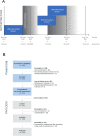Impact of COVID-19 restrictions on behavioural and psychological symptoms in home-dwelling people with dementia: a prospective cohort study (PAN.DEM)
- PMID: 35074810
- PMCID: PMC8787843
- DOI: 10.1136/bmjopen-2021-050628
Impact of COVID-19 restrictions on behavioural and psychological symptoms in home-dwelling people with dementia: a prospective cohort study (PAN.DEM)
Abstract
Objectives: To investigate the impact of the COVID-19 restrictions on behavioural and psychological symptoms of dementia (BPSD).
Design: Prospective cohort study (PAN.DEM) nested within the halted parent trial (LIVE@Home.Path).
Setting: Households in Norway immediate before and 6-9 weeks into the COVID-19 restrictions.
Participants: 104 dyads (persons with mild to moderate dementia aged ≥65 and their informal carers) completed both prepandemic and pandemic assessments, among 237 in the parent trial. Mini-Mental Status Examination score 15-26 or Functional Assessment Staging score 3-7 covered dementia severity.
Main outcome measures: Neuropsychiatric Inventory (NPI-12) total (range 0-144), psychosis (range 0-24), hyperactive behaviour (range 0-60) and mood subsyndrome (range 0-48) scores; Cornell Scale for Depression in Dementia (CSDD) total score (range 0-38).
Results: We found an overall increase in BPSD by NPI-12 total score comparing prepandemic to pandemic levels (median 16 IQR (4.5-29) to 20 (7-32.5), p=0.03) over a mean of 86 days (SD 19). NPI-12 total score worsened in 57 (55%) of people with dementia and was associated with postponed or averted contacts with healthcare professionals (logistic regression, OR 3.96, 95% CI 1.05 to 14.95). Psychosis subsyndrome levels increased (0 (0-3) to 0.5 (0-6), p=0.01) in 37 (36%) persons; this worsening was associated with partial insight (9.57, 1.14 to 80.71) and reduced informal carer contact (4.45, 1.01 to 19.71). Moreover, depressive symptoms increased as assessed by CSDD total score (5 (3-9) to 7 (4-12), p=0.01) and worsened for 56 (54%), which was inversely associated with psychotropic drugs on-demand (0.16, 0.03 to 0.75).
Conclusions: BPSD worsened during the first months of the COVID-19 restrictions, most pronounced for psychosis and depression. These BPSD exacerbations have implications for pandemic policies, emphasising that restrictions must balance COVID-19 morbidity and mortality against dementia deterioration.
Trial registration number: NCT04043364; Results.
Keywords: COVID-19; dementia; health policy; old age psychiatry; primary care.
© Author(s) (or their employer(s)) 2022. Re-use permitted under CC BY-NC. No commercial re-use. See rights and permissions. Published by BMJ.
Conflict of interest statement
Competing interests: All authors have completed the ICMJE uniform disclosure form at www.icmje.org/coi_disclosure.pdf and declare: MHG, MV, JM and LIB had financial support from the Research Council of Norway (grant number 273581), for the submitted work; no financial relationships with any organisations that might have an interest in the submitted work in the previous three years; IVV reports receiving honorarium as editor of the American Journal of Geriatric Psychiatry.
Figures


References
-
- Suárez-González A, Livingston G, Low L-F. Impact and mortality of COVID-19 on people living with dementia: cross-country report, 19 August 2020. Available: https://ltccovid.org/wp-content/uploads/2020/08/International-report-on-... [Accessed Aug 2021].
-
- World Health Organization . Mental health and psychosocial considerations during the COVID-19 outbreak. Available: https://apps.who.int/iris/handle/10665/331490 [Accessed 18 Mar 2020].
MeSH terms
Associated data
LinkOut - more resources
Full Text Sources
Medical
